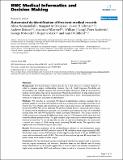Automated de-identification of free-text medical records
Author(s)
Neamatullah, Ishna; Douglass, Margaret M.; Long, William J.; Szolovits, Peter; Moody, George B.; Clifford, Gari D.; Reisner, Andrew T.; Lehman, Li-Wei; Villarroel, Mauricio C.; Mark, Roger G; ... Show more Show less
Download1472-6947-8-32.pdf (343.0Kb)
PUBLISHER_CC
Publisher with Creative Commons License
Creative Commons Attribution
Terms of use
Metadata
Show full item recordAbstract
Background: Text-based patient medical records are a vital resource in medical research. In order to preserve patient confidentiality, however, the U.S. Health Insurance Portability and Accountability Act (HIPAA) requires that protected health information (PHI) be removed from medical records before they can be disseminated. Manual de-identification of large medical record databases is prohibitively expensive, time-consuming and prone to error, necessitating automatic methods for large-scale, automated de-identification. Methods: We describe an automated Perl-based de-identification software package that is generally usable on most free-text medical records, e.g., nursing notes, discharge summaries, X-ray reports, etc. The software uses lexical look-up tables, regular expressions, and simple heuristics to locate both HIPAA PHI, and an extended PHI set that includes doctors' names and years of dates. To develop the de-identification approach, we assembled a gold standard corpus of re-identified nursing notes with real PHI replaced by realistic surrogate information. This corpus consists of 2,434 nursing notes containing 334,000 words and a total of 1,779 instances of PHI taken from 163 randomly selected patient records. This gold standard corpus was used to refine the algorithm and measure its sensitivity. To test the algorithm on data not used in its development, we constructed a second test corpus of 1,836 nursing notes containing 296,400 words. The algorithm's false negative rate was evaluated using this test corpus. Results: Performance evaluation of the de-identification software on the development corpus yielded an overall recall of 0.967, precision value of 0.749, and fallout value of approximately 0.002. On the test corpus, a total of 90 instances of false negatives were found, or 27 per 100,000 word count, with an estimated recall of 0.943. Only one full date and one age over 89 were missed. No patient names were missed in either corpus. Conclusion We have developed a pattern-matching de-identification system based on dictionary look-ups, regular expressions, and heuristics. Evaluation based on two different sets of nursing notes collected from a U.S. hospital suggests that, in terms of recall, the software out-performs a single human de-identifier (0.81) and performs at least as well as a consensus of two human de-identifiers (0.94). The system is currently tuned to de-identify PHI in nursing notes and discharge summaries but is sufficiently generalized and can be customized to handle text files of any format. Although the accuracy of the algorithm is high, it is probably insufficient to be used to publicly disseminate medical data. The open-source de-identification software and the gold standard re-identified corpus of medical records have therefore been made available to researchers via the PhysioNet website to encourage improvements in the algorithm.
Date issued
2008-07Department
Harvard University--MIT Division of Health Sciences and Technology; Massachusetts Institute of Technology. Computer Science and Artificial Intelligence Laboratory; Massachusetts Institute of Technology. Department of Electrical Engineering and Computer Science; Harvard--MIT Program in Health Sciences and Technology. Laboratory for Computational PhysiologyJournal
BMC Medical Informatics and Decision Making
Publisher
BioMed Central Ltd
Citation
Neamatullah, Ishna et al. “Automated de-identification of free-text medical records.” BMC Medical Informatics and Decision Making 8.1 (2008): 32.
Version: Final published version
ISSN
1472-6947